How is the sewer layout in a private house: a review of the
Do not think that the layout of sewage in a private house is impossible with their own hands. In fact, it is not so difficult task to not be able to do it yourself.
Of course, as in any niche, there are many nuances that need to be taken into account, but in general, if you are theoretically grounded, then doing this kind of work is more than realistic. Without hiring third-party teams.
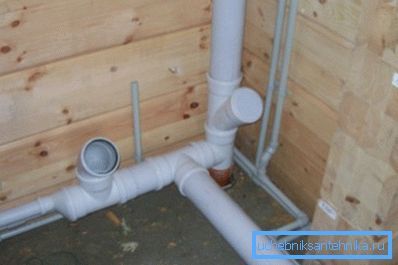

In this article we will understand in detail how the sewage system is planned and carried out in the apartment and in the house.
Let's start with the most important point.
How to choose a pipe for the device line
Consider all the options in the comparative table.
| Product type | Special features |
| 1. Metallic. | Such lines may be made of cast iron or steel. What is the difference between such material and high strength. That is, such pipes can be easily filled with earth, stones, etc. But if you touch the negative side of the issue, then a whole list of shortcomings pops up. This is a lot of weight, susceptibility to corrosion, and difficulty of processing. |
| 2. Plastic. | These are modern lightweight products that are easy to install, are not at all afraid of rust and temperature changes. In addition, inside these highways are very smooth, which allows sewage to pass without any delays. Due to this property - it will be necessary to rarely clean the plastic system. As for the shortcomings, we can distinguish such moments as the fear of mechanical shocks. And the price of good plastic materials is not very low. |
In principle, it turns out that the best option is distributing sewer pipes and plumbing from plastic. Because the system is quite realistic to mount quickly, while it will last a very long time.
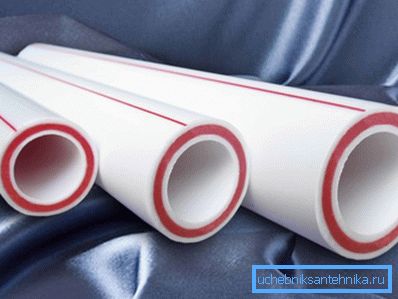
Tip: do not worry about the fact that the plastic is sensitive to mechanical shocks. First, usually such a highway is still protected by something, and, secondly, the same cast iron is also quite a brittle material. In standard situations for the installation of sewage systems it is better to choose PVC pipes.
So, with what better work we decided, now let's move on to the practical part of the article.
Independent device of sewer system
It is worth noting one important point.
The layout of the sewage in a private house is practically no different from planning a similar line in the apartment. In both cases, there is one common thing - this is the place where sewers enter the interior of your room. And it is precisely at this point that all the living quarters are connected.
In a high-rise building, such a drain is, as a rule, in a general standpipe, which “leaves” in the sewage wells of the city. And in a private building, the exit section may lead not to a central sewage system, but to a usual drain hole located somewhere in the courtyard.

This is the only difference - the layout and the layout principle are exactly the same. Consider how exactly the layout of sewer pipes in a private house and apartment.
It all starts with the design.
Plumbing Location Planning
This refers to the fact that you first need to clearly define where these items will stand:
- Toilet;
- Bath;
- Washbasin;
- Kitchen sink, etc.
How to proceed:
- Take the plan of an apartment or house, or draw it with your own hands.
- In the kitchen, toilet and bathroom, you can see where exactly the above mentioned appliances will be.
- You measure the distance from the walls to the resulting points and transfer them to the plan.
After that you can proceed to the next stage.
Calculation of fittings and system length
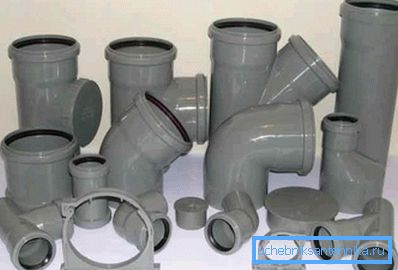
Since we already have the discharge points, both on paper and in fact, we will build on them.
We need to calculate the total footage of the highway. To do this, we simply simply measure the distance between the extreme marks, and add 30 percent to the sum obtained. This will be the necessary indicator of the square footage.
Depending on it, the required number of pipes in pieces is determined.
Please note that during such work it is necessary to calculate exactly where the connections between the pipes and the various fittings will be located, and only then determine a clear number. If this is not done, then it may be that the corners or other adapters will have to be mounted inside the partition, which, of course, is very inconvenient. Believe me, sometimes it is easier to change the plan of the line and add another pipe to the structure than to organize a complex connection in an awkward place.
What needs to be done next is to reveal all the turning points. This is done right on the plan. Only here it is important to remember that the direction of turns can be not only from side to side, but also up and down.
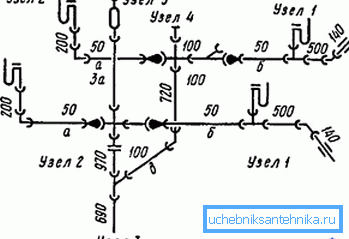
After such areas are identified, we determine how many fittings with a certain degree of rotation are needed. And having such data, you can go to the store and purchase the necessary material.
Just keep in mind that it is still important to decide how plastic will be attached to the wall. If the products can be fixed from the outside, as if on the plane of the walls and the floor, then special fittings should be purchased. And if you do not avoid laying the route or its individual sections inside the walls, then you will need a cement-sand mortar.
Let's look at exactly how the sewage pipes are laid in a private house.
System installation
As an illustrative example, take the most difficult option - the assembly of the pipe, which are laid inside the walls.
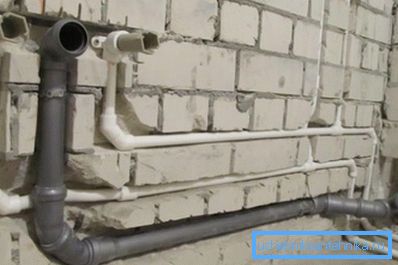
For quick and effective work, besides the sanitary products themselves, we need this:
- Perforator.
- Tape measure and pencil.
- Rule with level.
- Trowel and bucket for mortar.
- Bag DSP.
- The drill with a diameter of 6 mm. and paddle blade.
- U-shaped fastenings from galvanized steel for rigid fixation of pipes.
- Dowel.
- Sanitary silicone.
- Hammer, Phillips screwdriver.
In principle, with such a set, you can safely begin work.
This is done approximately according to this scheme:
- On the surface of the wall we draw lines along which the system will be laid..
- We take a puncher, put a fender blade on it and start making shafts (grooves) for plastic in the wall. The width and depth of the "route" should be a couple of centimeters larger than the diameter of the pipes for internal sewage. Such a gap is needed in order to be able to change the horizontal position of products, if necessary.
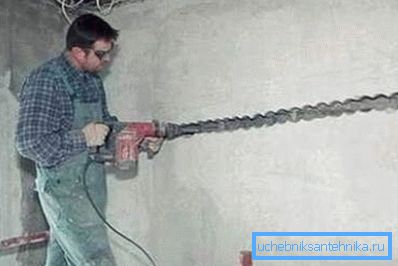
- After the channels for laying pipes are ready, it is necessary to thoroughly clean the surface of the recesses so that there are no hidden sharp stones, pieces of reinforcement, etc. left. If they remain, there is a risk of damaging the plastic during installation.
- Now we take a perforator, put a drill on it, prepare the P-shaped images and use them to fix the pipes to the wall, connecting them in series. At the same time, it is desirable to begin assembly from the point of entry of the main sewer line into an apartment or house. If you "go" on the contrary - to it, then there is a possibility that it will simply not be possible to insert the pipes into the main channel at the end of the work.
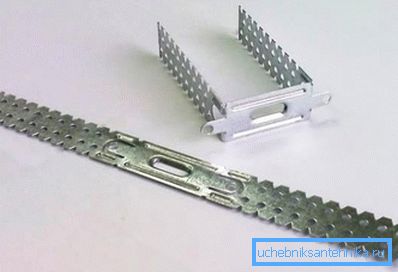
Please note that the layout of the sewer in the bathroom and in any other implies the presence of a mandatory slope in relation to the main point of the drain. If the inclination is not, then the water simply simply will not flow through the system in the right direction. As a rule, a bias of a couple of centimeters by two meters is enough.

- After the pipes are fixed and, in fact, the “route” is assembled, it is necessary to check its operation.. To do this, water is poured into every point of the drain - if it can be seen that it is quietly leaking, then everything is in order, the pipes can be sealed with a cement-sand mortar.
Filling with the solution is easy - we mix the solution with water, and as if we throw in all the grooves with the resulting mass. And after the working mixture grabs a little, the trowel must cut off the excess protrusions relative to the plane of the wall. (See also the article Connecting the toilet to the sewer: features.)
On this our review and installation instructions for sewage in the house are completed.
Let's summarize the article.
Conclusion
As you can see, there is nothing difficult in the layout of such a system. We hope that after reading these tips and instructions, you can do everything yourself. If the information did not seem to be enough, then check out the informative video in this article.